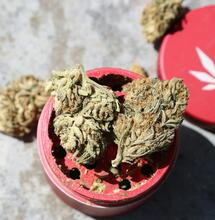What Does the Future of Cannabis Look Like?

Cannabis is now mainstream. A big hype. Countries all over the world are rapidly moving on with legalization. A Thai-made cannabis toothpaste has recently made the headlines of major outlets. Enter the nearest pharmacy, you'll probably find extraordinary products such as cannabis-based creams said to heal hemorrhoids. Even the most unlikely Hollywood stars are launching their cannabis brands these days. That's probably more than anyone could have ever imagined from a sector that has largely operated in the shadows, in an entirely gray area for so many decades. A plant that was once brutally demonized and banned for all and any use for almost a century is now changing the face of modern medicine. So, what does the future of Cannabis hold?
As we enter the final months of 2022, it's clear that we will have to wait a bit longer until the U.S. government legalizes marijuana at the federal level. Whenever that happens, federal decriminalization will effectively remove major obstacles that halt the sector's growth.
What's also clear is that the legal portions of the industry are now so big that there's no going back. The stakes are too high. Too much has been invested.
Cannabis has also shown exceptional resilience during the pandemic, giving all the more hopes that its future is bright.
As per the societal and political agents who back up campaigns against marijuana, they will always be here, too. In their view of the world, the freedom of smoking weed just for the fun of it will remain a deeply-disturbing act of immorality, more so than the freedom to keep an assault weapon within the hand reach of children.
Below is an overview of what else you can anticipate from the Cannabis sector in the years to come.
The Future of CBD is Secured
The medicinal use of cannabis has been legalized in at least 45 countries worldwide, with legal countries present on every continent. This number climbs even more if we consider countries with more restrictive laws that allow only the use of certain cannabis-derived pharmaceuticals such as Epidiolex for epilepsy or Sativex for multiple sclerosis symptoms treatment.
In the United States, 37 states, four territories, and the District of Columbia have legalized the medicinal use of cannabis, although the ban at the federal level persists.
With such an outstanding number of jurisdictions where weed is legal for medical purposes, it's safe to assume the industry will further grow its already well-established medical segment.
CBD is the most widely used cannabinoid for medicinal purposes. According to a new study by Grand View Research, Inc., the global CBD market is expected to gross over $22 billion by 2030. North America has the largest revenue share in this market, and it's expected to maintain its lead over the forecast period.

The Rise of Minor Cannabinoids
Novel technologies are bringing to perfection the extraction processes for other minor cannabinoids with proven health qualities, such as CBN or CBG.
According to some estimates, the U.S. market for minor cannabinoids, including cannabigerol (CBG), cannabichromene (CBC), cannabinol (CBN), tetrahydrocannabivarin (THCV), and cannabigerolic acid (CBGA) is projected to reach an astonishing worth of $26.2 billion by 2028.
The rising popularity of these cannabinoids will inevitably affect other individual markets. For example, CBN is very similar to the sleep aid melatonin, and it's expected to take a more prominent role in the U.S. sleep-aid market. The value of the U.S. sleep aid market was estimated at around $31 billion in 2020. CBN is expected to reach sales of $2.4 billion by 2025 as the FDA hopefully classifies it as a dietary ingredient similar to melatonin.
Recognition of Cannabis as a "Super Plant"
It's very well known that cannabis medicines have helped so many people combat deadly diseases such as cancer or help neutralize even the most brutal seizure attacks in epilepsy patients. But no matter the magnitude of the success of healing with Cannabis, you won't read about it in major news outlets.
The benefits of cannabis medicine are usually reported to the masses with careful measuring of words. Most content will caution that "more research needs to be done" as it arguments whether cannabis can help with cancer, pain, or you name the disease.
This could all change with total legalization as well as the ultimate recognition that Cannabis is a "super-plant" or "superfood." Hopefully that happens sooner rather than later.
What are "super plants"? It's any nutrient-rich plant that contains beneficial compounds with the ability to treat various symptoms and disorders. Superfoods have the potency to boost the immune system while addressing all 11 of our biological systems via the endocannabinoid system.
The systems supported by plants include the integumentary system (or the skin and its appendages), the muscular, skeletal, lymphatic and nervous systems, the respiratory, endocrine, reproductive, urinary and immune systems.
The list of superfoods typically includes most berries, broccoli, spinach, lettuce, salmon, etc. Unfortunately, beneficial herbs such as ginger, lavender, mint, and yes cannabis among others, rarely get a mention on any such list.
The versatility of medicinal uses of the cannabis plant, its ability to stimulate appetite, tackle waste loss, and help improve conditions affecting various body systems, do make cannabis an eligible plant-based super ingredient. "Official" recognition as such could change the public discourse on Cannabis, granting it more serious media coverage. It will also lead to the creation of substantial educational resources for medical professionals to learn about cannabis and the endocannabinoid system and with that to become better herb practitioners.
Finally, it will leave less space for political calculations among legislators about a plant capable to heal conditions that big pharma can't, which brings me to the next prediction.
Substitute for big pharma
Cannabis will take a significant chunk of the profits of established pharmaceutical companies. In fact, it's what has been happening ever since legalization started to advance more than a decade ago. Research on the topic has already been done.
Investors' predictions say that full legalization in the U.S. may reduce drugmaker annual sales by an average of $3 billion.
Cannabis may provide therapeutic benefits for a variety of diseases and there's a constantly growing awareness among the public about this. The further legalization of cannabis could lead to more people substituting conventional medications for cannabis as access and use expand.
Since the use of cannabis is not limited to treating a single or limited number of diseases, Cannabis would simultaneously be a new entry across many different drug markets.
Recreational products can be as accessible as conventional over-the-counter medications. Buying it in a store without a prescription from a healthcare professional would make it even more appealing to try.
In addition, legal homegrowing would also increase the number of potential users as people would have the option to grow their own medicine for little money.

Subduing Illegal Markets
In the future, law enforcement will remain a crucial component of ensuring a safe and secure market.
Market transitions from illegal to legal are not simple. In Ontario, Canada, it has taken four years for legal retail to finally outperform illicit sales across the province.
California offers a grim picture of a legal future that went south. After the implementation of Proposition 64, once lauded as a landmark piece of legislation, the Golden State has seen an unprecedented spike in illegal farming. A legislation landscape with reduced penalties designed to help those disproportionally affected by the War on Drugs has unfortunately attracted lucrative criminal networks that have in turn harbored violence, labor exploitation, water theft, and other forms of societal and environmental harm.
Law enforcement in California has been overwhelmed by the scope of criminal activities they need to tackle. Six years after legalization, Cali's illegal trade network still makes more profits than legal operators. The Californian case is something that any jurisdiction that regulates cannabis will want to avoid in the future.
Even though a significant portion of any law is about taxing and making profits from a plant that should in essence be free, legislation and enforcement remain the best chance to keep cannabis widely accessible for everyone.
The War May Slow Down the Future
Europe is currently experiencing the most serious security crisis since World War Two. In addition, the war in Ukraine has sent energy prices soaring.
Before the war, there was much more focus on cannabis reform across the European block, but it doesn't look like that's the case anymore. At least not this winter. And not in Germany, the continent's biggest market. Cannabis legalization won't be a hot topic for discussion among politicians as the war escalates.
While Ukraine does not supply medical cannabis on the market and there are no direct consequences for business, there are many visible indirect consequences, such as the rising gas and energy prices. With that, the cannabis industry is now facing the same burden as any other sector.
The rising energy prices will put a strain on cannabis production in Europe, from cultivation to processing and packaging. As the war rages on (it has recently entered a new stage with Russia's proclaiming annexation of four of Ukraine's oblasts), rising costs and inflation will continue to impact all sectors, including transportation and storage.
If the cannabis sector can take destiny into its own hands this time and prove that it is a significant player in the labor market, it may encourage lawmakers to proceed with legalization rather than saving the conversation for after the war is over.
However, as the world is headed into yet another uncertain winter, it's becoming more evident that the future of cannabis in Europe will be late. How much late, it again depends on politicians.

_11zon.jpg)

















